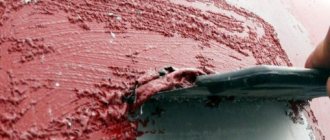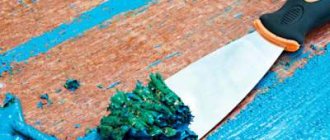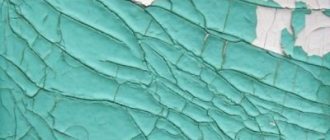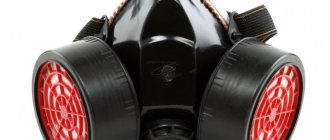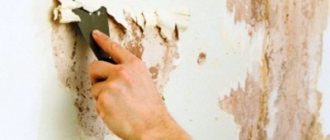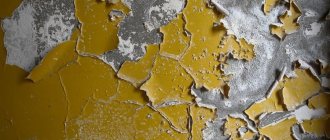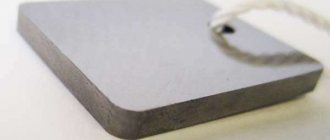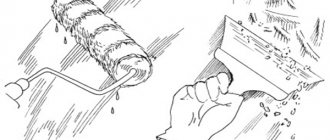All the ways to remove old and fresh paint from walls: methods for quickly removing all types of paint
The bathroom is usually finished with tiles, which are quite easy to dismantle if necessary. However, sometimes the walls are covered with paint, in which case it will take some effort to remove it.
- Easily remove paint from bathroom walls
- When to remove old paint from bathroom walls
- Clean the surface of the walls in the bathroom from paint: what tools are needed
- Using a hammer and chisel
- Using paint remover
- Using a cord brush
- Grinding machine and diamond cutter
- Ax and warm water
- How to remove old paint from bathroom walls
- Clean the water-based base
- Quickly remove emulsion from concrete walls
- How to Clean Oil Paints
- How to remove old textured paint
- Is it possible to remove decorative painted surfaces with appliqués?
- What to do after cleaning the base coat of paint
- What mistakes are most often made?
- Useful video
Features of removal depending on the type of paint and base
Before you start removing paint from the walls, you need to assess the situation:
- determine the type of paint and the base underneath it;
- decide how much time and money you are willing to spend;
- Choose the appropriate paint removal option.
Types of paint
To determine the type of paint, start with a visual assessment. Enamel and oil paints have a glossy surface. Water-based compositions are easily washed away with water. Acrylic does not shine and does not dissolve in water.
Water-based
Often used on ceilings and in dry rooms, removing such paint from the wall is as easy as shelling pears:
- Pour warm water into a basin.
- Dip a roller or rag in water and wet the walls.
- Wait 15-20 minutes.
- Remove the coating with a spatula.
Tip: Before starting work, cover the furniture and floors with film.
Instead of a roller or rag, it is convenient to use a pump sprayer - fill it with hot water and spray. It is also convenient to soak wallpaper.
Acrylic
Unlike water-based paints, this one will have to be scraped off while working on a dry surface.
You can remove acrylic paint from the walls of a bathroom or other room using coarse sandpaper - however, it will take a long time to rub and you will need more than one sheet.
Another option is temperature. Using a hair dryer, heat up the old paint and remove it like a film. The detailed technique is described in the video.
Tip: If you plan to reapply acrylic paint to the walls, you don’t have to remove the old coating.
Oily
base, you will have to try. A solvent will help remove oil-based paint from small areas, but it has a strong odor and if the room does not have sufficient ventilation, it is better to avoid this option.
Proven temperature method to remove paint from a wall:
- Heat the area with a heat gun.
- Remove paint using a spatula.
Important: When heated, caustic substances are released into the air, so you need to work in a respirator and in a well-ventilated apartment.
The safest, but longest method is mechanical. A hammer drill with a special attachment will help speed up the process; the process is described in the video:
To reduce the negative impact of vibration on your joints, wrap the attachment with a rag or foam rubber.
Base
The choice of path for removing the old coating, as well as its speed and complexity, is influenced by the base.
Concrete
One of the most problematic combinations is an old layer of Soviet oil paint on a concrete wall. However, due to the porosity of the material, it is not easy to remove any composition from it. The advantage is that you can use any method: mechanical, chemical or thermal.
Plaster
Due to the ability of plaster to swell, removing paint from the walls above it will not be difficult. The simplest order:
- Make notches on the surface.
- Apply warm water using a roller or sprayer.
- Leave to act for 20-30 minutes.
- Remove the paint along with the plaster.
Brick
Any brick, be it silicate or ceramic, is defenseless against chemical compounds, so the use of a remover is discarded. You will not only spoil the appearance, but also destroy the masonry itself. Hard mechanical cleaning with sand or a hammer drill is also dangerous for brick.
The most reliable option in this case is sandpaper or a spatula. Or, in order to save time, you can order a soft blasting service from professionals:
Removing Acrylic Paint
If the walls in the bathroom are painted with acrylic-based paint, then it will be impossible to get rid of it with water alone. Acrylic paint can only be knocked down or scraped off. In this case, it is better not to moisten the coating, but to work on a dry surface.
You can remove acrylic paint with coarse sandpaper or an ordinary metal dish brush. Remember that the higher quality the paint, the more difficult it will be to get rid of. If you plan to reuse acrylic paint for wall decoration, then the old coating does not need to be removed.
Sources
https://o-vannoy.ru/remont/kak-snyat-krasku/ https://vannayasovety.ru/voprosyi-otvetyi/kak-snyat-krasku-so-stenyi-v-vannoy.html
Chemicals
For those who do not want to do hard physical work, we can recommend a less labor-intensive method - dissolving paint using various chemicals. Let's consider several of the most accessible means.
Organic solvents
This type of substance includes, for example, acetone or white spirit. It should be remembered that they are far from harmless and can have a strong toxic effect. It is for this reason that at the time of work there should be no pregnant or nursing women, children, allergy sufferers or asthmatics in the house. Anyone who will remove paint should take care to protect the eyes, respiratory tract and mucous membranes.
The solvent is applied to the wall using a roller or wide brush and left until the paint softens. After this, it is removed with a scraper or spatula. If the wall is covered with several layers of paint, then each layer is removed separately. At the final stage of work, it is recommended to wash off any remaining solvent from the wall.
A mixture of soda ash and quicklime
You can also prepare a solution for removing old paint at home yourself. To do this you will need one and a half kilograms of lime and half a kilogram of soda. Prepare a suitable container, pour both components into it, then, stirring, slowly add water. Stop when the mixture has the consistency of runny sour cream.
Removing water-based paint
Water-based paint is often used to decorate walls in rooms with high humidity levels. Despite the fact that water is one of its main components, it will not be possible to remove the water-based emulsion simply by washing it off with water. First, you will have to thoroughly wet the walls with plenty of warm water, wait until the paint softens, and only then proceed with removal.
To thoroughly moisten the walls, it is most convenient to use a roller. In this case, water must be applied to the paint again and again, because it dries very quickly. Soaked paint gets very dirty, so before starting work it is recommended to cover all soiled surfaces.
In addition to water, to remove water-based paint, you can also use wallpaper glue, paste, or PVA diluted in water.
How to remove paint from the walls in an apartment in different ways
We will analyze in detail different cleaning technologies.
Mechanical
Painting is removed using hand tools: chisel, knife, spatula, suitable scraper. Sometimes an ax is used. Before cleaning, you need to prepare the instrument. The blade is sharpened sharply. It must be securely attached to the handle, since significant forces are applied to it during the process of removing the finish. We offer instructions for mechanical cleaning.
Step by step process
- We attach the device to the wall, positioning it at an acute angle. We hit him quickly, but hard. This is how a notch is formed.
- We cover the surface with notches. We do them as often as possible.
- Fill the spray bottle with water. Wet the notched surface generously.
- We wait until the moisture is absorbed and the paint layer swells.
- Scrape or knock down the swollen material.
Before work, you should put on clothes made of thick fabric that cover your arms and legs. Safety glasses are required. Otherwise, sharp fragments of the removed coating may injure the worker. Handle the ax especially carefully.
Electromechanical
Improved mechanical technique. For cleaning, use a power tool with special attachments. This saves time and gives good results. For cleaning use:
- Drill plus a paint remover attachment. This is a part assembled from three metal chains. When rotating, they break up the paint layer, which flies off in small pieces with minimal dust.
- Drill plus crown attachment. Effectively and quickly destroys worn-out finishes. This creates some dust and dirt. The risk of injury is low. The downside is that the expensive attachment quickly breaks down and has to be replaced.
- Grinder grinder. For cleaning, a wheel with an abrasive coefficient of 40 or higher is installed on it. Sometimes a sanding brush with steel wire instead of bristles is chosen as an attachment.
Electromechanical cleaning is not recommended for soft bases. An electrical unit can damage them. It is important to remember safety rules and follow all instructions for working with equipment.
Thermal
This method is suitable for quickly removing paint from walls. The essence of the technique is to heat up the paint film. It cracks, lags behind the base and is easily removed with a spatula. It is very convenient to work in pairs. One person heats the material, the other cleans the surface. They heat the surface with various devices.
- Construction hairdryer. The nozzle is directed at the area to be cleaned and brought close to the wall. Turn on the unit at full power and wait for a while. If the amount of work is small, household appliances are used in the same way. But they are less powerful and can break if used for a long time.
- Portable burner. A blowtorch runs on gasoline or kerosene vapor, which is quite dangerous. The nozzle is brought close to the surface to be cleaned and exposed to an open flame. It is important not to miss the moment when the finish begins to melt. Otherwise it will catch fire, and this is dangerous.
- Iron. Set the maximum power on the device scale and heat it up. Cover a section of the wall with foil and press an iron against it. The melted paint is removed. It is necessary to ensure that the foil does not tear. Otherwise, the soleplate of the iron will be damaged.
The thermal method is effective, but is absolutely not suitable for plastic or metal. Use with extreme caution on wood. It is forbidden to heat the surfaces behind which electrical wiring passes. It is undesirable to use the burner in apartment buildings; the risk of fire is too great. In any case, heat treatment is accompanied by a pungent odor and the release of toxic substances. Respiratory protection and good ventilation in the room are required.
Chemical
A stripping solvent is applied to the used coating. It destroys the hardened paste, after which it can be easily removed with any sharp tool. It is important to choose the right drug. A composition for acrylic, for example, will not work on enamel, and vice versa. Oil dyes are sometimes removed using white sprit, acetone or other solvents. This method is good for a fresh finish. In other cases, it is better to use a remover.
The drugs come in different forms, so they are also applied in different ways. Liquids are best sprayed with a spray bottle. Gels are applied with rollers or brushes.
Chemical cleaning instructions
- Apply the preparation liberally to the base.
- We wait for the time indicated on the package for the product to destroy the finish.
- Use a metal brush or spatula to remove the peeling design.
- Wash the cleaned surface with diluted citric acid or vinegar.
When working with chemicals, it is important to remember safety rules. Protective equipment and good ventilation are required. In the process of destruction of the coloring paste, a sharp unpleasant odor may appear, accompanying the release of toxins. If this causes discomfort (nausea, dizziness), you must immediately go out into fresh air.
To chemically clean the base, in some cases homemade preparations are used. We offer two options for such mixtures.
- Take 10% ammonia in an amount of 250 ml, pour it into a liter of cold water. Two kilograms of chalk need to be crushed, the powder should be poured into an aqueous solution of ammonia. Add in portions, mix thoroughly, rub out any lumps. The result is a paste-like mixture. We apply it to the surface to be cleaned and distribute it evenly. Leave for two to three hours. Then scrape off the swollen finish with a sharp scraper.
- Take 400 g of soda ash, mix it with 1,200 g of quicklime. Mix the powder well. Pour clean water into it little by little and stir. The result should be a thick paste with the consistency of high-quality sour cream. Apply the mixture thickly to the wall. Leave for 12 hours, preferably longer. Then use a sharp device to remove the swollen paintwork.
How to remove paint from a bathroom wall
Andrey. K. Stavropol. I was thinking of putting tiles on the walls in the bathroom. I heard that tiles won't stick to old paint. Can you tell me how to remove paint from a wall?
Many people face the problem of removing paint when planning a bathroom renovation. Just a couple of decades ago, such wall decoration was fashionable. Before laying the tiles, the paint must be removed, otherwise the new cladding will very quickly fall off in whole fragments. This is not an easy task and the speed of removal will directly depend on the type of paint and the surface on which it is applied. Study the article and use the tips and supporting video.
Mechanical removal methods
Let's consider simple mechanical methods that do not require special skills.
- An ax and water will work on a plastered wall. By tapping with a sharp ax like a hammer on a wall, notches are made. The wall is wetted, and then the paint layer is scraped off with an ax blade at an angle to the wall. The method is long and labor-intensive, but the notches will further ensure good adhesion of the tiles to the wall. In addition, the risk of injury is minimal, and there is almost no dust, which is important for a room with a small area.
Removing paint with an ax
- If the paint peels off and, as they say, falls off on its own, a spatula or scraper will be enough.
- An angle grinder will speed up the peeling process, but there will be a lot of dust. Here you will have to work for a minute and wait half an hour for the dust to settle. Although there are mechanisms with a built-in vacuum cleaner, which makes the procedure clean.
Removing paint with a grinder A good result is obtained with a drill with various attachments, namely:
Using a drill with an attachment - paint remover in the form of a chain;
- brush;
- crown for concrete.
The brush produces a lot of fine dust, and the chain knocks off the paint in chunks. When using a chain paint remover, the nozzle must be pressed firmly with the nut, and the rotation of the drill must be set to the left. The nozzle is used until at least three links remain on it. When a link is knocked off on one side of the chain, then on the other side, for balance, it is also necessary to press out the link.
Chemical paint removal
Paint removers greatly simplify the process, but are not entirely safe. When working in a small bathroom, do not forget about rubber gloves and respiratory protection. To avoid poisoning from toxic fumes, do not close the doors to the room.
When working with chemicals, be sure to protect your hands
- Various paint converters and solvents contain caustic substances that etch the paint. Suitable for removing any paint. The essence of the procedure is simple. Apply the composition to the wall with a roller or brush. Movements are best done in one direction. The liquid has the appearance of a thick jelly and can cause a burn if it comes into contact with the skin. And the smell of such a drug is not pleasant. After application, wait about half an hour, the paint will begin to wrinkle and swell. The paint dissolution time may be longer. Remove it with a spatula. If the coating is very old and durable, and even applied in several layers, re-application of the drug may be required. And do not forget to tightly close the lid with the solvent after work. We remove the remaining product with a stiff brush using progressive movements, and then rinse with water several times with the addition of calcium carbonate. The last flush is done with clean water.
Removing paint after exposure to solvent
- If the adhesion of the paint to the base is weak, then you can try a solution of 1.5 kg quicklime and 500 g of calcined salt. Apply this mixture to the wall with a brush, and after 12 hours remove it with a spatula.
- Liquid glass, when dried, creates a durable film on the paint and peels off well with it. The procedure is similar to the previous method.
Temperature method
You will need a hair dryer or a blowtorch. First, try heating and scraping a small area with a spatula, the fact is that some paints adhere even more strongly to the concrete surface when heated. Remove the swollen paint immediately, otherwise later, as they say, you won’t be able to get it off with your teeth. Thermal removal is very toxic and there is a risk of fire. Follow all safety precautions.
Construction hair dryer
Now you know everything about how to remove paint from a wall. It’s easier and faster to do this with a grinder, and use a hammer drill to prepare the wall for tiling. Use the method that suits you best.
Method for removing paint from a wall: video
Grinder - effective cleaning of walls from paint
An angle grinder or grinder is a very effective tool for removing paint from a bathroom wall. To do this, you need to use a segmented disk for working on stone, concrete, and porcelain stoneware. Different grinding discs will not be effective. Flap discs for sanding quickly become clogged with dust; discs based on sandpaper last just a couple of minutes of work.
Hold the grinder at an acute angle to the surface and make movements from top to bottom. Unfortunately, this method has a huge drawback. You have to pay for efficiency and there will be a lot of dust. You will have to work in a gas mask. But if you are prepared for a lot of dust, then clean the wall quickly and without much effort.
Professionals use a bowl-shaped diamond blade. This allows you to use the entire working surface of the disk. One square meter of wall is cleaned in just a few minutes in perfect quality. To do this, you need an angle grinder with a dust removal function and a construction vacuum cleaner.
Cleaning with power tools
You can make your work easier by using an electric tool - a drill, grinder or hammer drill.
We work with a drill
To remove paint with a drill, you must use a special attachment. This could be a nozzle developed by “folk craftsmen”, which is a metal rod on which short metal chains consisting of three links are located at equal distances from each other.
When you turn on the drill, the chains unwind and begin to rotate quickly, that is, in working condition the device resembles a fan or propeller. A drill with a rotating “propeller” is brought sideways to the painted wall, the chains will hit the surface, knocking off pieces of paint.
Advice! When using this and other methods of cleaning walls from paint using power tools, be sure to use safety glasses and a respirator, since flying paint particles can damage your eyes or enter your respiratory system.
When using this method, you need to periodically stop work and inspect the tool chains. The fact is that the links fray during operation and if they are not replaced in time, the worn link can fly off and cause serious injury.
Please note that the number of links on all three chains must be the same, otherwise the tool will not work. Therefore, you cannot simply remove a worn link; it must be replaced.
A chain tool can be used to remove paint only if the layer is not dense enough. In difficult cases, it is worth using another option for a drill attachment - a crown for drilling large-diameter holes in brick.
To clean the wall of paint, you will need to get used to it; it is important that the crown removes the paint layer, but does not begin to go deeper into the concrete. Therefore, you need to move the tool along the wall with a certain speed and pressure. The optimal speed and pressure are selected experimentally.
We use a hammer drill
You can also use a hammer drill with a spatula-shaped attachment to clean walls from old coating. A standard spatula is included in the package, but you can find an improved version - a spatula with a wider and thinner edge, it is ideal for removing the paint layer.
At the first stage, the paint layer needs to be “broken”, so there is an impact load on the wall. The hammer drill is held at right angles to the wall, making sure that the blows are superficial, but strong, so as to leave “breaks” in the paint layer. Then you need to turn the tool so that it is located at an acute angle to the wall and use a spatula to clean the wall of paint.
Using an angle grinder
A grinder can provide effective assistance in cleaning walls from old paint. To do the job, you must select the “correct” disk. So:
- discs based on sandpaper should be immediately put aside; they will last for 1-2 minutes of work;
- the petal disk is also a bad choice, as it will quickly become clogged with dust;
- The ideal choice would be a segmented blade designed for working on stone or a bowl-shaped diamond blade.
Using a grinder, you can effectively and quickly clean surfaces from the old paint layer. The machine must be held at an acute angle to the wall, moving the tool from top to bottom. The disadvantage of this method is that a large amount of dust is generated during cleaning.
How to remove paint from bathroom walls? There are several ways to solve this difficult problem. Each method has its own advantages and certain disadvantages, so when choosing, you will have to weigh all the arguments in order to choose the optimal solution to the problem.
Required tools and materials
Cleaning walls of old paint requires some preparation. First of all, to remove paint from walls you will need the following set of tools:
- elements protecting the face and hands - respirator, mask/construction glasses, rubber gloves;
- a blowtorch, or better yet a special hair dryer used in construction;
- sharp spatula, scraper, knife and chisel;
- a chemical liquid for removing old paint from walls and a small brush that you don’t mind;
- a large sharp object like an ax for cutting notches;
- electric drill, hammer drill and grinder;
- attachments for hammer drills and electric drills.
Methods
How to remove old paint from bathroom walls? There are several methods for doing this job. You can destroy the paint layer in the following ways:
- thermal;
- chemical;
- mechanical, and you can mechanically clean the paint manually or using a power tool.
Thermal impact
The essence of this method is to burn out a layer of paint by exposure to high temperature. To do this job you will need a gas torch. The walls are treated, as a result the paint layer fades, leaving bare concrete walls. However, removing paint from walls using this method is very rarely used due to the large number of disadvantages. This:
- the need to buy special equipment, yet a gas burner is not an essential item in a city apartment;
- unsafe from a fire safety point of view and the risk of damaging any elements in the room, for example, plastic communications;
- a health hazard; when a layer of oil paint burns, toxic substances are released, and since the work is carried out, as a rule, in a small room without a window, the risk of poisoning a working person is high. After all, it is unlikely that anyone will work wearing a gas mask, and the ventilation in the bathroom will not cope with the rapid removal of toxic substances;
- Some types of paint are heat resistant, so it is extremely difficult to remove them by heating.
Advice! Since there are more negative aspects when using this method than positive ones, you should resort to the thermal method only in extreme cases.
Chemical methods
When deciding how to remove paint from walls, you can “call to the rescue” of chemistry, or rather solvents that dissolve the old coating. In fact, this method is a symbiosis of two methods - chemical and mechanical.
Using a solvent, the paint layer is softened, after which it is quite easy to remove it with a scraper. The work is carried out like this:
- apply solvent to the painted part of the wall (starting from the top), you need to work with a roller or brush and apply the solvent liberally;
- then wait several hours for the paint to soften;
- then carefully remove the paint using a scraper.
The method seems quite easy, but it also has a lot of disadvantages. This:
- the pungent smell of solvents that are used to remove paint from the wall. Ventilation in the bathroom is unlikely to cope with removing the smell; most likely, it will spread throughout the apartment;
- It is necessary to protect the skin and mucous membranes from contact with the solvent, as this substance can cause a burn.
Advice! In addition, if the paint layer is thick, that is, the walls have been tinted several times, then the solvent may not cope with its functions in one go. You will have to repeat the processing, which is extremely unpleasant.
Mechanical and manual
The safest method from an environmental point of view is the mechanical method of removing paint from walls. But this method is the noisiest, so you need to be prepared that the neighbors will be extremely unhappy.
According to the law, noisy work in the apartment cannot be carried out during the day at lunchtime (from 13 to 15 hours), as well as in the evening and at night - from 19 to 9 hours. In addition, you cannot make noise all day long on Sundays and holidays.
Advice! Please note that requirements for “quiet hours” may vary in different regions. Therefore, this question needs to be clarified in advance.
How to remove paint from a bathroom wall using a mechanical method? The simplest, but most ineffective method is for the worker to take a scraper and begin to methodically remove the old finishing layer.
The disadvantage of this option is that it is labor intensive. If the paint layer adheres tightly, it will not be easy to remove it manually; the work will require a lot of time and physical effort. Another manual, but more effective method of removing paint layers is to use an axe. If you choose this method, please note:
- the ax must have a rounded blade;
- After completing the work, the ax will most likely become unusable and will have to be thrown away.
The work is carried out like this:
- using an ax we make very frequent cuts on the wall;
- then warm water is generously applied to the wall from a sprayer;
- now you need to wait a few minutes, during which time the plaster will swell and the paint will begin to peel off;
- now it needs to be removed using a scraper or the same ax, performing chopping movements.
Thermal method
To quickly remove paint, professional finishers often use the so-called thermal method, which involves exposing the old finish to high temperatures. The paint should be heated using a powerful hair dryer, and removed with an ordinary spatula.
The hot air stream must be directed at an angle; Experienced craftsmen manage to simultaneously heat the surface with a hairdryer and work with a spatula. The disadvantage of this method is that it cannot be used on sections of the wall where electrical wiring is laid. In addition, when heated, the paint releases toxic substances, which are quite harmful to inhale.
